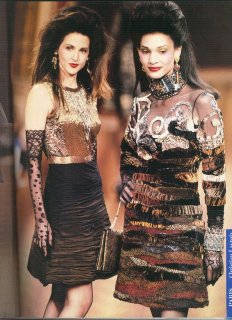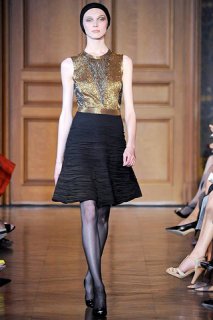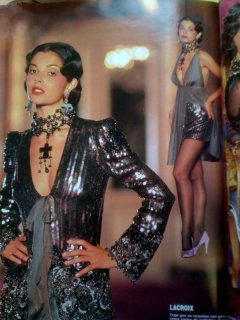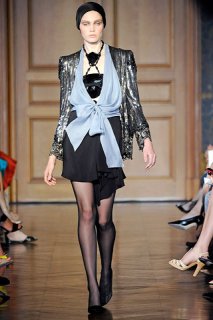You are using an out of date browser. It may not display this or other websites correctly.
You should upgrade or use an alternative browser.
You should upgrade or use an alternative browser.
Christian Lacroix Haute Couture F/W 09.10 Paris
- Thread starter HeatherAnne
- Start date
eternitygoddess
Active Member
- Joined
- Jun 30, 2004
- Messages
- 7,915
- Reaction score
- 29
Viva la Lacroix!

vogue.com
PARIS, July 7, 2009
By Sarah Mower
It was one of the most poignant and emotionally fraught haute couture shows ever: a collection produced on a shoestring at the last minute, and only made possible by the collective will and donated time and skills of the seamstresses, embroiderers, jewelers, milliners, and shoemakers loyal to Christian Lacroix. As the whole world knows, his future is in limbo after his former owners put the Lacroix business into administration and laid off all but 12 workers—an unclear and messy situation that leaves one of the greatest creators of the genre out on his own. Only the models were paid—50 euros each, according to French law — but they too ended up in tears. "I didn't want to cry," said Lacroix, amid a standing ovation and a tumult of support from clients. "I want to continue, maybe in a different way, with a small atelier. What I really care about is the women who do this work."
If the collection was a pitch to new backers, it was one that showed Lacroix at his most restrained and approachable. Without access to the oodles of extravagantly hued and embellished materials he has lavished on his couture fantasias since 1987, he pared it back to mainly black and midnight blue, concentrating on shape and wearability. Little caped coats and coat-dresses, short and flirty bell-shaped skirts, peplum jackets, and bunchy taffeta party dresses all brought rapturous applause from a packed room of friends and clients. Fantasia it wasn't, and couldn't be. Yet no financial constraints can detract from Lacroix's mastery of his art: witness the simplicity of a floor-length navy one-shouldered dress swooping into an asymmetrically curved back with a satin bow nestled into one side. Then there was the extraordinary wedding dress, an eau de nil satin gown with a gilded headdress, a vision evoking an image of a saint on a devotional church painting. As the designer came out to lead the bride in the finale, the whole audience stood to honor him.

vogue.com
FashionablyVivid
Member
- Joined
- Apr 12, 2008
- Messages
- 99
- Reaction score
- 0
This show blew my mind, he is a sensational artist as usual. So sad to see him go. Good luck to him, he is a great visionary!!!
Ferdinanda
lay lady lay
- Joined
- Jul 29, 2007
- Messages
- 3,115
- Reaction score
- 4
Some of this is quite Armani.
I thought the same. The tailoring of the jackets, paired with a skirt is very deja vu from Fall Couture 2007.

elle.com
And then the Russian influnces, like Chanel's Pre-Fall show. The color scheme is boring, and the clothes are unoriginal, coming from Lacroix I am dissapointed to say the least.

D
Deleted member 7575
Guest
perfection !
and the 7th look ... mmm ... very YSL, non ? LOVE IT ! Bourgeoise and Paris !
and the one before the wedding dress ... FAINT !
i like he closed his show with a VERY Lacroix wedding gown !
I think most of the collection is very YSL, down to the wedding dress.
Sunnyinlondon
Member
- Joined
- Jan 6, 2008
- Messages
- 72
- Reaction score
- 2
Lacroix Recycles
No one loves Lacroix more than I do and I never thought I would live to see him recycling past collections, though he used some previously shown couture pieces on a PAP presentation a few years ago. These two garments are from his Nightmare before Christmas Haute Coture show for Autumn/Winter 1994-95. The first one was modelled by Suzanne Von Aichinger. The gun metal sequined jacket was part of an outfit modelled at the time by Carla Bruni. I must have a picture of her somewhere.
First picture is a scan from Collezioni Alta Moda Winter 1994
Second picture courtesy of style.com
Third picture is a photo taken by me from Hola Alta Costura Otono 1994
Fourth picture courtesy of style.com
No one loves Lacroix more than I do and I never thought I would live to see him recycling past collections, though he used some previously shown couture pieces on a PAP presentation a few years ago. These two garments are from his Nightmare before Christmas Haute Coture show for Autumn/Winter 1994-95. The first one was modelled by Suzanne Von Aichinger. The gun metal sequined jacket was part of an outfit modelled at the time by Carla Bruni. I must have a picture of her somewhere.
First picture is a scan from Collezioni Alta Moda Winter 1994
Second picture courtesy of style.com
Third picture is a photo taken by me from Hola Alta Costura Otono 1994
Fourth picture courtesy of style.com
Attachments
I think Ms. Lacroix did the best he could under the circumstances to present a full collection. Pointing out the recycled outfit does nothing to diminish him in my eyes. Rather, it speaks volumes about the situation he was in. I understand it is 100% fair to point out the recycling, but in my heart I wish you wouldn't...
VerdeShimmer
Member
- Joined
- Jan 29, 2009
- Messages
- 134
- Reaction score
- 0
I really love the makeup looks!
No one loves Lacroix more than I do and I never thought I would live to see him recycling past collections, though he used some previously shown couture pieces on a PAP presentation a few years ago. These two garments are from his Nightmare before Christmas Haute Coture show for Autumn/Winter 1994-95. The first one was modelled by Suzanne Von Aichinger. The gun metal sequined jacket was part of an outfit modelled at the time by Carla Bruni. I must have a picture of her somewhere.
First picture is a scan from Collezioni Alta Moda Winter 1994
Second picture courtesy of style.com
Third picture is a photo taken by me from Hola Alta Costura Otono 1994
Fourth picture courtesy of style.com
Makes little difference.
If a garment is right for a moment, then it is right for a moment. What he recycled seems perfect for 2009 and very modern in every way. I think it is perfectly acceptable and even a tad nostalgic, which I like as an idea. Hopefully, both looks will sell this time around (I am sure they will) to ladies who will wear them with great admiration and love.
He has shown some of the chicest coats and jackets in this collection. Great embroidery and just the right amount of sparkle. This collection is nothing if not absolutely tasteful and elegant.
And all the girls look like a million bucks... very very rich ladies of Paris no matter how little money was spent to put this together.
That said, Sunnyinlondon: good eye.
KhaoticKharma
Amour Comme Hiver
- Joined
- Jul 13, 2005
- Messages
- 4,550
- Reaction score
- 10
It's wonderful that he would do this show... couture really does mean very much to many of us. As a teenager living in the middle of nowhere, a place where Dooney and Bourke bags and Abercrombie jeans are considered "fashion," nothing is more fantastic than to escape for a while into a world of wonderful fabrics, impeccable exocution, and gorgous silhouettes. I greatly appreciate artists like Mr. Lacroix, and truly hope that he will be able to continue to share his gift with the world. 

eternitygoddess
Active Member
- Joined
- Jun 30, 2004
- Messages
- 7,915
- Reaction score
- 29
KhaoticKarma, that describes my experience with couture too. Fantastical escapism from the mundane everyday life.
KbyKristina
Member
- Joined
- Mar 22, 2009
- Messages
- 934
- Reaction score
- 0
I hope its not the end..  I love his collections...
I love his collections...
 I love his collections...
I love his collections...fashionispassion
Member
- Joined
- Jun 18, 2009
- Messages
- 148
- Reaction score
- 0
amazinggggggggggggggg
Similar Threads
- Replies
- 125
- Views
- 19K
- Replies
- 209
- Views
- 63K
- Replies
- 7
- Views
- 8K
- Replies
- 15
- Views
- 3K
Users who are viewing this thread
Total: 1 (members: 0, guests: 1)


 For the first time!
For the first time!


